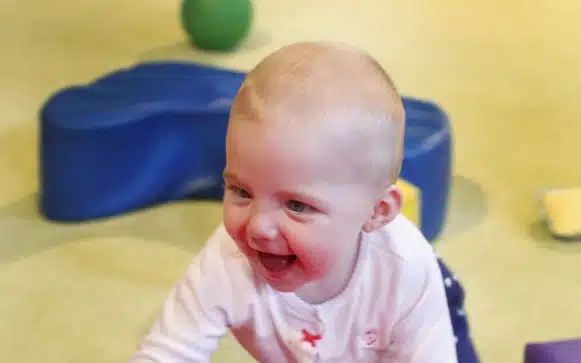Though times have changed, this parental fear/question is timeless: how to encourage baby to crawl? I very often worried about whether my daughter would crawl at all since we had a a very difficult tummy time experience together. It wasn’t just my daughter that shed tears.
In prevention of SIDS, health professionals stress that children sleep on their backs. Research suggests that this has inadvertently delayed children in reaching developmental milestones, and in some cases according to occupational therapists, they have skipped them all together.
As a result, we have shied away from allowing our children to spend too much time on their tummies, and the result is that they aren’t getting enough “tummy time” — the key ingredient for developing upper body strength and instrumental towards how to encourage baby to crawl.
My daughter would scream and protest when I placed her on her stomach, and it was almost as painful as sleep training. I remember being exasperated with our pediatrician when she expressed dismay at our lack of tummy time. However, I’ve come to understand over my years as a teacher, the positive ways to improve tummy time and why our doctor rightfully prompted us to work towards it.
Your child’s overall body and the development of it, is benefited by the act of crawling. Below is my list of five essential items to understand about crawling as well as tips on how to encourage baby to crawl.
You and your child can smile through it with both love and teamwork!
(1) Crawling is important for a babies overall strength
We are fortunate as teachers at Bubbles Academy to have the professional support of area physical therapy specialists. I asked Katie Rule, Manager of Physical Therapy at Lurie Children’s Hospital, for her professional stance on why crawling is important:
“Crawling is an essential motor milestone, not to be missed! Crawling develops motor planning, sequencing, core musculature, problem solving and even handwriting skills.” — Katie Rule
(2) Get your workout in while helping your baby crawl
Our babies learn by watching us model for them and there is no better way to do that then to get down on the floor and interact with them. I like to think of tummy time and crawling as doing “baby planks.” I whine when I do planks to strengthen my core, and naturally, so does your baby. It’s tough to lift and engage the core, but it does work.
This is a great time to bond with your baby. Distract each other with a fun toy or by making silly faces or playing peek-a-boo. Your baby will be happy just to be with you!
(3) Use bubbles as a method towards how to encourage baby to crawl
Bubbles as well as any interesting object or toy are great tools towards how to encourage your baby to crawl. Mirrors are also a wonderful enticing object.
According to Early Intervention Support, when babies determine visually what they want and where they want to go, they use binocular vision as they crawl. This means they look forward towards the destination/item and then back down at their hands. Children will use this skill later in life in the classroom, and especially for athletics and coordination.
(4) Explore the environment together
Occupational Therapists for children tout the benefits of crawling for sensory integration. As a mother, I know that there is nothing more wonderful than lying on the ground with your baby and experiencing the wonder of the environment through his/her eyes. Use the delight of these first experiences to inspire your child to crawl — investigating the textured surfaces in the room. Sensory stimulation is on high when one is on their hands and knees.
(5) Milestones don’t have to be difficult for you or your baby. Embrace them!
The more often you practice, the more natural and comfortable your baby will be with these new movements. Muscles have great memories and so do children. Once they work out the initial difficulties, they will find joy in their newfound stealth and swiftness — crawling will become their choice mode of transportation.
Recap:
- Crawling engages the entire body and uses the legs and arms to lift the body off of the ground. The ability to lift the body this way has a significant affect on wrist strength, which is vital for activities such as throwing and writing later in life.
- Crawling stimulates brain development, strength, and coordination, as well visual, audio and sensory development.
Hands-on Guidance: I’m teaching a brand new class, Bubble Reach for pre-crawlers! Together we lay the foundation for children to be resilient, strong crawlers and later walkers through engaging tummy time, stability-building games and open gym exploration. Join in this spring!
Embrace and encourage the time on all fours. It is the only time that your child will be able to appreciate the world from this vantage point. Before you know it, your little one will be off and running!
Tummy time, crawling nerves, or other antidotes/questions to share?! We want to hear below and @BubblesAcademy.
How to encourage baby to crawl: please always consult your pediatrician regarding your child’s development and best practices. It is easy to fall into the trap of comparing your child to other children, when in reality, there is a very broad range as to what is normal within the developmental milestone spectrum.

Kim Schiefelbein
Kim Schiefelbein is the Senior Director of Music and Community Programming at Bubbles Academy. Kim leads the development and teaching of the music curriculum and partners with Neighborhood Parents Network to present their Chicago School Choice workshops. A certified fitness instructor, Kim also leads the Stroller Fitness program.
